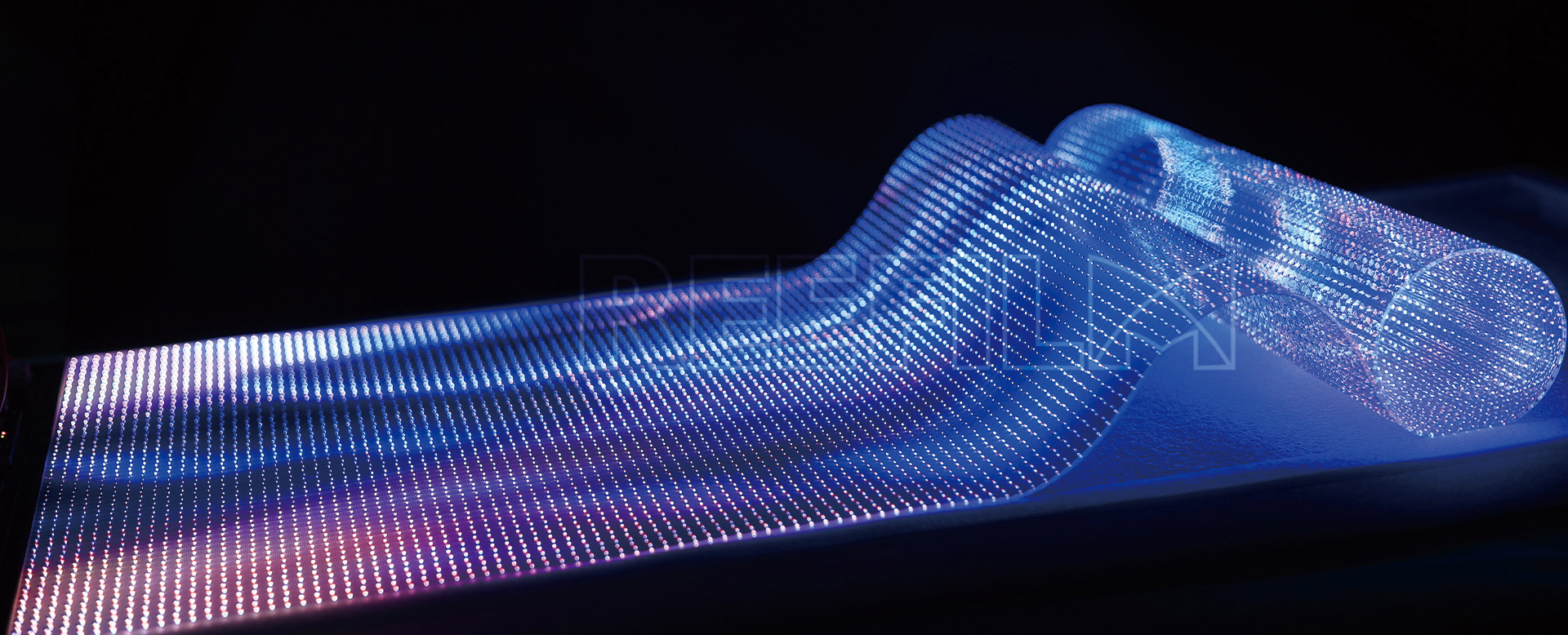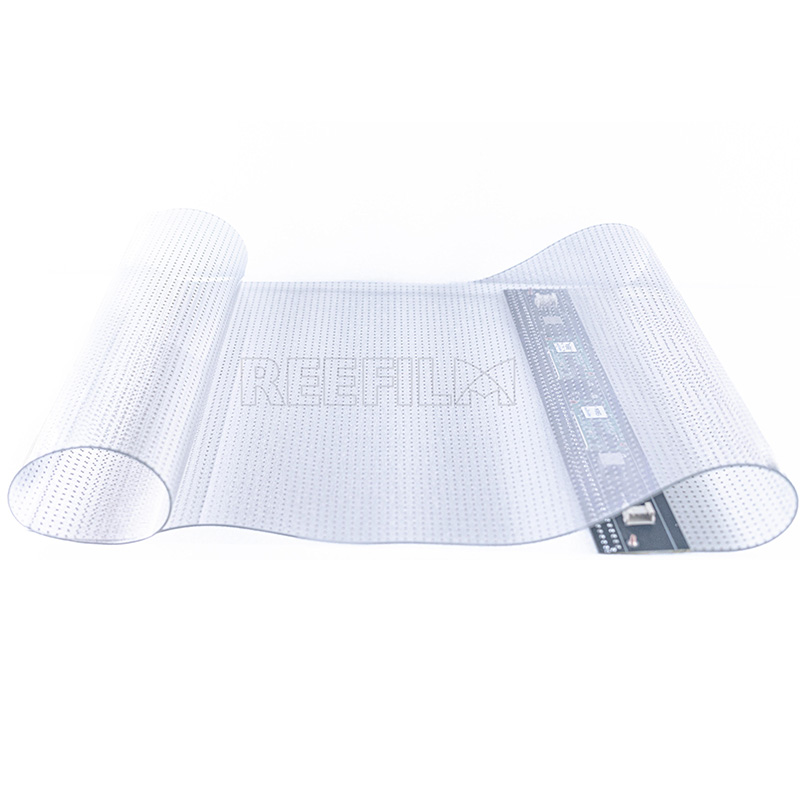
Led Transparent Screen is an innovative display device that uses LED technology to achieve a translucent display effect. Due to its unique transparency and thin design, it is widely used in shopping malls, building curtain walls, stage displays and other occasions. Unlike traditional LED screens, Transparent LED Screens not only have high-definition display functions, but also maintain visibility behind the screen, which makes it extremely advantageous in the fields of advertising display and art design. This article will introduce in detail the production process of Led Transparent Screens and their particularities.

Basic structure
The Transparent Led Screen consists of multiple transparent LED light strips, which are arranged vertically and horizontally on the screen to form a grid-like display array. Each LED light strip is embedded with multiple micro LED lamp beads, and the gaps between the light strips provide a transparent effect, allowing the audience to see the objects behind the screen while watching the screen content.
LED transparent screens usually use high-transmittance materials as support structures, such as transparent glass or acrylic panels. The LED lamp beads are fixed to the supporting material through a special packaging process to form a translucent display panel that can display the picture and allow light to penetrate.
Manufacturing process
PCB design and production: The PCB (printed circuit board) of the LED transparent screen is usually designed as a strip structure, which can maximize the light transmittance of the screen. In order to ensure the transparent effect, the PCB board will be made extremely fine and thin. When designing the circuit, it is necessary to consider the uniformity of signal transmission and power supply to ensure that the LED lamp beads can emit light evenly across the entire screen.
LED lamp bead packaging technology: The display effect of the LED transparent screen depends largely on the quality and packaging technology of the lamp beads. The lamp beads need to be packaged with a small pitch to ensure a high-resolution display effect. At the same time, the packaging process of the lamp beads needs to be waterproof, dustproof and UV-resistant to improve the adaptability and durability of the screen in outdoor environments.
Screen module assembly: When making a transparent LED screen, multiple light strips are usually assembled in modules first. Each module consists of several LED light strips to ensure that the connection between the modules is tight and stable. In order to improve the flexibility of installation, quick plug-in connections are usually used between modules, which is convenient for users to splice screens of different sizes and shapes according to actual needs.
Control system integration: The display of the LED transparent screen requires a precise control system to manage the brightness, contrast and color performance of the image. Through the control system, users can remotely control and adjust the screen content in real time. The control system of the transparent LED screen usually supports multiple input signals, including HDMI, DVI, VGA and other interfaces, to ensure its compatibility with multiple devices.
Debugging and testing: After the screen is assembled, each module needs to be strictly debugged and tested. First, the brightness and color uniformity of the LED lamp beads should be tested to ensure that the light emitted by each module is consistent and the display effect is clear. Then the screen is tested in high temperature, humidity and other environmental conditions to ensure its stability under various extreme conditions.
Installation and debugging: The last step is to install the screen module to the predetermined position and debug it on site through the control system. Due to its light weight and simple installation, the LED transparent screen can be quickly installed on the glass curtain wall of the building or the exhibition display area.
Speciality
High transparency: The most notable feature of the transparent LED screen is its high light transmittance. The light transmittance can usually reach 50% to 90%, making the screen almost integrated with the background when not playing content. This feature is particularly suitable for occasions such as building curtain walls and shopping mall windows, without affecting the indoor lighting or blocking the appearance of the building.
Thin and light design: Since the transparent LED screen adopts a thin and light light bar structure, the overall screen weight is relatively light. The weight of the screen per square meter can be as low as less than 10 kilograms, which makes installation more convenient and reduces the load on the building structure. At the same time, the screen thickness is usually controlled within 10 mm, which greatly saves installation space.
Energy saving and environmental protection: The energy-saving advantage of transparent LED screens is significant. Since the transparent design of the screen reduces unnecessary light blocking, the luminous efficiency of LED lamp beads is higher. When displaying content, only the corresponding part of the lamp beads need to be lit up, rather than the full light of the entire screen, thus achieving energy saving and consumption reduction. This energy-saving effect is particularly important for advertising screens or display screens that are used for a long time.
High-definition display: Although the main feature of the transparent LED screen is its transparency, it still has high-definition display capabilities. Through the arrangement of LED lamp beads with small spacing, the screen can present clear and delicate picture content, which is suitable for playing videos, pictures, text information and other content, meeting the display needs of different occasions.
Wide application scenarios: The versatility of transparent LED screens makes it widely used in many fields. For example, the transparent LED screen in the window of a shopping mall can play advertising content without blocking the goods on display in the store; the transparent screen in the stage background can create a visual effect of combining virtuality and reality; the transparent LED screen on the curtain wall of a building can be used to publish public information or advertisements without affecting the exterior design of the building.
Customized design: Transparent LED screens can be customized according to the needs of different occasions. Whether it is the size, shape, transparency or resolution of the screen, it can be flexibly adjusted to ensure that it meets various building structures and display requirements. This customized feature provides a wide range of application prospects for transparent LED screens.
Convenient maintenance: The modular design of the LED transparent screen makes maintenance more convenient. When a module or light bar fails, only the module needs to be replaced without removing the entire screen, which greatly saves maintenance costs and time. In addition, transparent LED screens usually have good waterproof and dustproof capabilities, which prolongs their service life.
LED transparent screens have shown great potential in the field of display technology through advanced manufacturing processes and unique designs. Its high transparency, thin and light design, high-definition display, and energy-saving and environmental protection characteristics have made it widely used in both commercial and architectural fields. With the continuous advancement of technology, the display effect and performance of transparent LED screens will be further improved, and they will become more mainstream display devices in the future.